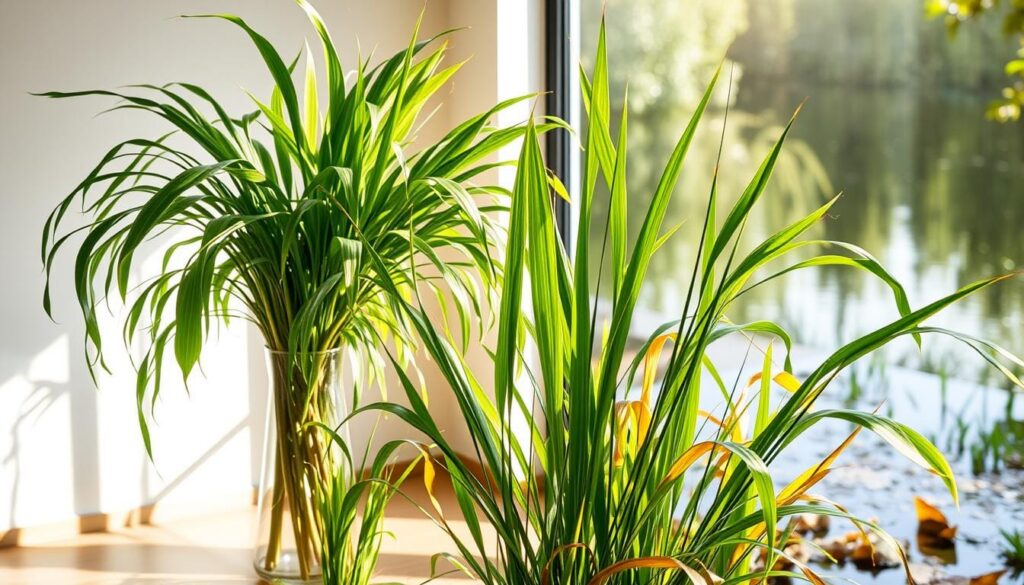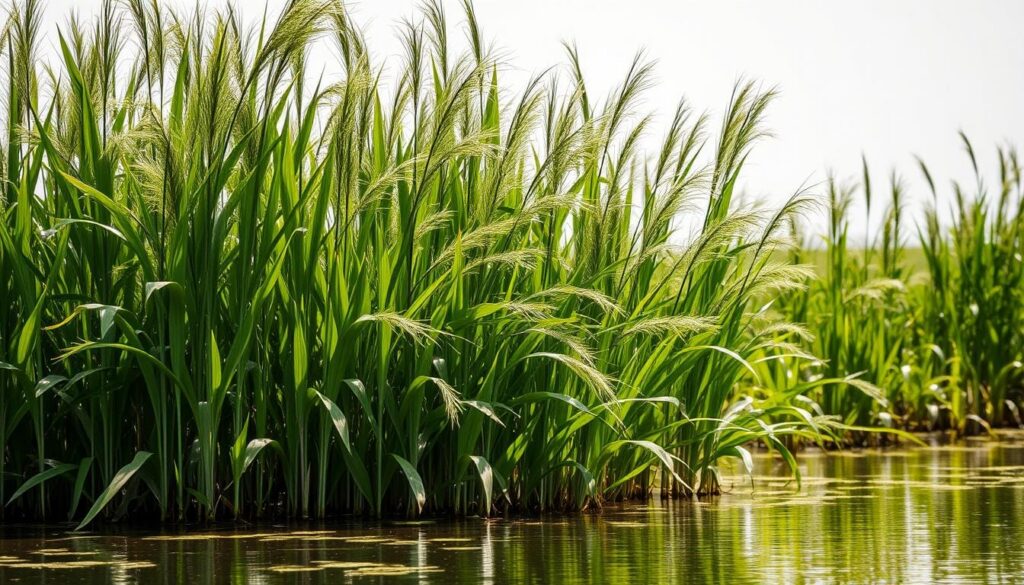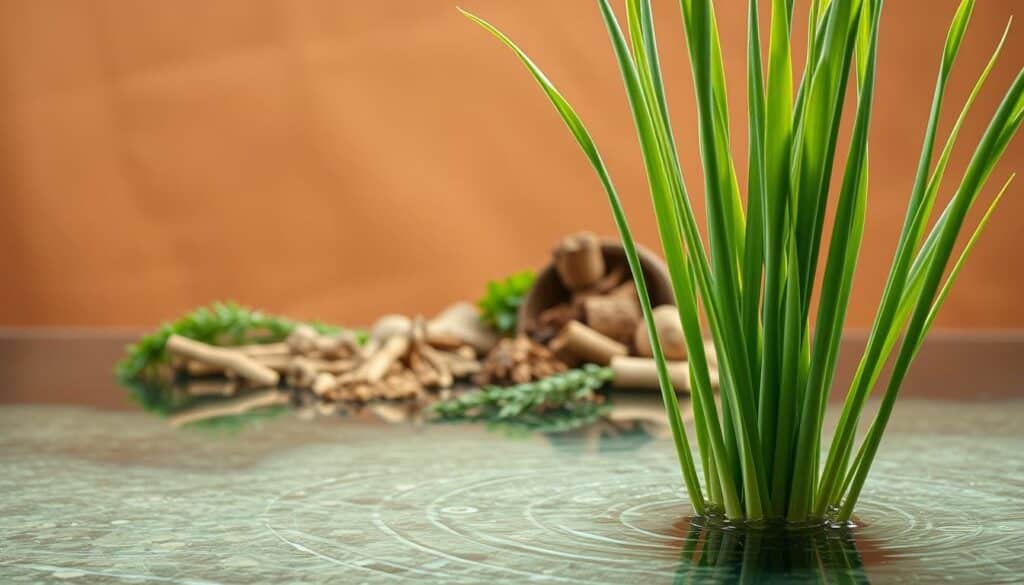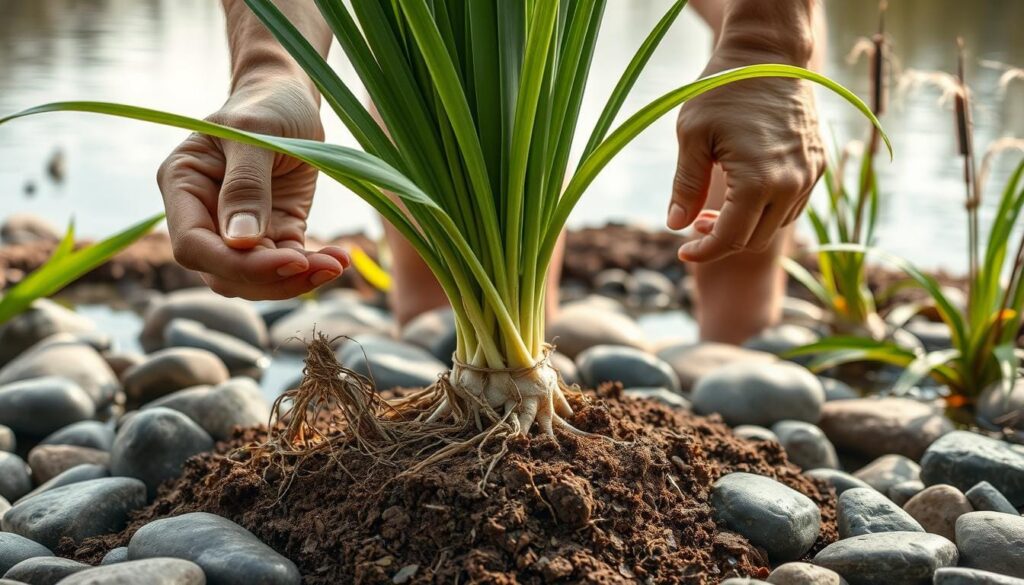Imagine a plant that connects ancient times to today’s decor. The papyrus plant, or Cyperus papyrus, has been around for thousands of years. It once grew by the Nile and now brightens up homes. It’s a timeless beauty that can transform any space, whether in water or indoors.
This plant has been a symbol of strength and beauty for ages. Now, you can bring it into your home. It fits well in any space, from indoor gardens to backyard ponds. Its unique look and heritage make it a standout feature.
Key Takeaways
- The papyrus plant (Cyperus papyrus) blends ancient history with modern home decor.
- Its unique umbrella-shaped foliage thrives in both water gardens and indoor settings.
- Originating in ancient Egypt, it symbolizes longevity and adaptability.
- Easy to care for, it adds tropical vibes without demanding high maintenance.
- Perfect for eco-conscious gardening due to its natural water-loving traits.
Overview of the Papyrus Plant
The papyrus plant (Cyperus papyrus) is a striking aquatic sedge thriving in wet environments. It’s known for its triangular green stalks and feathery flower clusters. This plant spans habitats from Egyptian marshes to modern garden ponds. Its role in creating ancient Egyptian paper is a key part of historical botany.
What is the Papyrus Plant?
The papyrus plant can grow up to 16 feet tall. It has upright stems with umbrella-like blooms. Native to Africa, it thrives in shallow waterlogged soil. Gardeners often grow it in containers to mimic its natural marsh environment.
Historical Significance of Papyrus
For centuries, Egyptians used this plant to make durable writing material—ancient Egyptian paper. They layered and pressed its fibrous interior to create scrolls. These scrolls were used for religious texts and administrative records. This innovation helped early civilizations preserve their knowledge.
Varieties of Papyrus Plants
- Cyperus papyrus: The classic species growing 8–15 feet tall
- Cyperus alternifolius: A shorter variety for smaller spaces
- ‘King Tut’ cultivar: A dwarf form ideal for indoor pots
Check out Chikus Garden’s guides to pick the right variety for your space. These plants are great for both water gardens and terrarium setups.
Ideal Growing Conditions for Papyrus
To make your papyrus plant happy, create a wetland-like environment. These tropical plants need the right sunlight, water, and soil to grow well in your garden or containers. Here’s how to care for your papyrus plant.
Sunlight Requirements
Papyrus plants love full sun to partial shade. They need 6–8 hours of direct sunlight each day. In very hot places, give them light afternoon shade to avoid burning.
Don’t put them in full shade. It slows down stem growth and flower production.
Water Needs
Keeping your papyrus plant moist is key. Plant it in containers or water gardens where the roots are always in 4–6 inches of water. For soil-grown plants, keep the soil wet all the time.
Letting the soil dry out can cause wilting and root rot. Use a drip irrigation system or put containers on saucers with water for the best hydration.
Soil Preferences
Choose nutrient-rich loamy soil that holds water well. For containers, add peat moss or perlite to keep moisture in. The University of Wisconsin-Madison Extension says using aquatic plant soils helps growth in new places. Stay away from sandy or dry soils that drain too fast.
Propagation Methods for Papyrus
Expanding your papyrus collection is easier than you think. You can start from seeds, divisions, or cuttings. These methods help you grow more plants with little effort. Follow these steps to multiply your papyrus and beautify your garden or indoor space.
Division Technique
Divide mature clumps every 2–3 years in spring. Use sharp, sterilized shears to cut through rhizomes. Make sure each section has roots and stems.
Replant divisions in moist soil or water. Keep the soil consistently wet for the best results.
Seed Propagation
Plant seeds in peat pots with sandy soil. Press seeds gently into the surface. Cover with a humidity dome.
Keep soil warm (70–75°F) and moist. Germination may take 2–3 weeks. Transplant seedlings once roots form.
Cuttings Method
Take 6-inch stem cuttings from healthy plants. Remove lower leaves, leaving 2–3 nodes exposed. Place cuttings in water, submerging nodes.
Roots develop in 2–4 weeks. Once roots are 2 inches long, transplant to pots or water gardens.
| Method | Ease | Timeframe | Best For |
|---|---|---|---|
| Division | Easy | 2–3 weeks | Establishing new plants quickly |
| Seeds | Moderate | 4–6 weeks | Large-scale propagation |
| Cuttings | Simple | 3–4 weeks | Home gardeners and small batches |
Caring for Your Papyrus Plant
To keep your papyrus plant looking great, focus on nutrients, grooming, and health checks. Regular care helps them grow well in any spot. Follow these tips to keep your plant green and healthy.
Fertilization Tips
Use balanced fertilizers made for aquatic plants to boost growth. For potted plants, add ¼ teaspoon of slow-release pellets in spring. For those in ponds, sprinkle fertilizer tablets near the roots every 6–8 weeks.
Too much fertilizer can harm the roots. So, don’t overdo it. Adjust how much you feed based on how well your plant is doing.
Pruning and Maintenance
Keeping your papyrus plant neat and encouraging new growth is key. Here’s how:
- Trim yellowing stems at their base with clean shears.
- Thin dense clusters by cutting outer stalks to allow airflow.
- Divide overgrown clumps every 2–3 years to prevent root overcrowding.
Common Pests and Diseases
Watch out for pests and diseases and act fast:
| Pest/Disease | Symptoms | Solutions |
|---|---|---|
| Spider Mites | Yellow stippling on leaves, fine webbing | Rinse foliage weekly; spray with neem oil |
| Aphids | Wilted leaves, sticky residue | Apply insecticidal soap or introduce ladybugs |
| Root Rot | Soft, brown stems, yellowing leaves | Trim affected areas; repot in fresh, well-draining soil |
Use eco-friendly methods like neem oil and manual removal to keep your plants healthy. Regular checks help stop small problems from getting worse.
Papyrus Plant in Aquatic Settings
Papyrus plants do well in water, making them perfect for water gardens and ponds. They grow tall and upright, adding beauty and helping the environment. Here’s how to use them in your water features.
Benefits of Growing in Water
The papyrus plant’s roots soak up extra nutrients, like nitrogen, which clears pond water. Their dense leaves block sunlight, stopping algae from growing. They also give homes to insects and tiny creatures.
- Water purification through nutrient uptake
- Algae control via shaded water surfaces
- Shelter for frogs, fish, and beneficial insects
Compatibility with Fish and Aquatic Life
Papyrus leaves are safe for fish and small animals. It doesn’t take over like some plants do. Its hollow stems are home to good bacteria, helping the pond.
Decorating with Papyrus in Water Gardens
Use papyrus to frame water features or as a centerpiece. Mix it with water lilies or iris for a layered look. For small spaces, try aquatic baskets filled with gravel. Here are some design tips:
| Setting | Planting Tips | Best Practices |
|---|---|---|
| Small Ponds | Group 3-5 plants in clusters | Trim yellowing stalks seasonally |
| Bog Gardens | Plant in moist soil at pond edges | Pair with cattails for natural filtration |
| Large Water Gardens | Create diagonal arrangements for depth | Anchor with heavy clay pots to prevent toppling |
Place plants in spots that get 4-6 hours of morning sun. This will help them grow well. Their tropical look adds a unique touch to any water garden.
Indoor vs. Outdoor Papyrus Plants
Deciding where to grow a papyrus plant depends on your climate and space. Both settings offer unique opportunities but need tailored care. Find out which environment is best for you.

Benefits of Indoor Papyrus
Indoor papyrus plants do well in humid bathrooms or kitchens. Their upright stems add a tropical touch without needing direct sunlight. Use containers with drainage holes and mist leaves weekly to keep them happy.
This setup is great for those with little outdoor space but want to grow papyrus indoors.
Outdoor Landscaping Ideas
- Water Gardens: Plant in ponds or tubs for a striking aquatic display.
- Bog Gardens: Thrive in moist soil mixed with peat moss.
- Container Groupings: Pair with ferns and irises for layered greenery.
For design inspiration, check out guides at Chiku’s Garden for seasonal arrangements.
Seasonal Considerations
In colder zones (USDA 9-11), outdoor papyrus may need winter protection. Bring potted plants indoors before frost, placing them near bright windows. Prune yellow leaves in spring to encourage new growth.
Outdoor plants in mild climates can stay year-round. But, they need periodic soil checks to avoid drying out. Adjust watering based on local weather patterns.
Using Papyrus in Home Decor
Make your space stand out with the papyrus plant’s classic beauty. Its tall stems and striking umbels are perfect for any room. Whether it’s a modern loft or a rustic living room, this plant brings nature’s drama inside. Find out how to use it in your home and discover its many uses beyond gardening.
Creative Display Ideas
Try these unique ways to display papyrus:
- Float clusters in sleek glass containers or ceramic pots.
- Create a focal point by grouping multiple papyrus plants in a bathtub or outdoor water feature.
- Mount stems vertically in moss-covered planters for wall displays.
Pairing with Other Houseplants
Pair papyrus with plants that match its moisture needs or look good together:
| Plant | Why It Works |
|---|---|
| Boston Fern | Soft feathery fronds contrast with papyrus’s rigid stems. |
| Water Lettuce | Complements floating side by side in water gardens. |
| Peace Lily | Shares low-light tolerance and tropical vibes. |
Seasonal Styling with Papyrus
Change up your display with the seasons:
- Summer: Surround with colorful floating flowers in a pond.
- Winter: Add evergreen accents like pinecones for festive flair.
- Holidays: Wrap stems in metallic ribbons for special occasions.
Ready to shop? Find papyrus plants for sale at aquatic nurseries, specialty garden stores, or online. Look for healthy plants with upright stems and no yellow leaves.
Environmental Impact of Papyrus Plants
Papyrus plants are vital in ecosystems, adding beauty and function. They help the environment in many ways. These aquatic wonders are key to keeping our planet healthy.

“Papyrus plants are nature’s guardians, stabilizing habitats and filtering water naturally.” — Wetland Conservation Journal
Habitat for Wildlife
These plants create homes for many animals. Birds like herons nest in them, and frogs and insects find shelter in the shaded roots. They are important for:
- Nesting sites for waterfowl
- Shelter for aquatic insects
- Nursery grounds for fish fry
Erosion Control Benefits
Papyrus roots hold soil in place. They are great for landscaping because they:
- Reduce shoreline erosion by up to 60% in wetlands
- Trap sediment during floods
- Stop soil runoff in water gardens
Carbon Sequestration
Papyrus absorbs CO₂ through photosynthesis. It stores carbon in its roots and the sediment. Studies show they can sequester 2-3 pounds of carbon annually per square meter.
By adding papyrus to gardens, we support biodiversity and environmental health. These papyrus plant uses make them a must for eco-friendly gardening.
Challenges of Growing Papyrus
Growing papyrus comes with its own set of challenges. Success depends on understanding climate, care, and avoiding common mistakes.
Climate Limitations
Papyrus grows best in USDA zones 9-11. But, it struggles in cold climates. Gardeners in colder areas must treat it as an annual or move it indoors during winter. A key tip: bring outdoor plants inside before it gets too cold, below 50°F (10°C).
Maintenance Commitment
Keeping up with how to grow papyrus plant routines is essential. Here are some key needs:
- Soil must always be moist, never dry.
- Split clumps every 2-3 years to prevent overcrowding.
- In winter, reduce watering and watch for light changes.
Common Mistakes to Avoid
Many problems come from poor care. Here are common mistakes to steer clear of:
- Underwatering: Dry soil turns leaves yellow. Check moisture every day.
- Low light: Place plants in bright, indirect light.
- Overfertilization: Use diluted fertilizer monthly when plants are growing.
- Ignoring winter care: Keep roots warm by insulating pots or moving plants indoors.
For success all year, combine this guide with seasonal gardening tips. With patience and careful attention, your papyrus plant will flourish.
Papyrus in Traditional Uses

The papyrus plant has shaped human culture for thousands of years. It was used for writing, building, and everyday life. Its uses show how it has adapted over time.
Historical Uses in Ancient Egypt
Ancient Egyptians madeancient Egyptian paperby layering papyrus stalks. They used these scrolls for laws, stories, and religious texts. They also built boats, mats, and ropes with the plant’s stems.
One interestingpapyrus plant factis that it was eaten. People ate its sweet core raw or made beer from it.
| Historical Use | Modern Parallel |
|---|---|
| Writing material (paper) | Decorative wall hangings |
| Boat construction | Basket weaving crafts |
| Food source | Edible landscaping trends |
Crafting and Art Applications
Artisans today use old methods to make new things. They make decorative paper by pressing papyrus layers. They also weave stalks into baskets or screens.
For those who like DIY, Chikus Garden has guides on growing and using papyrus.
Modern Uses in Home Decor
Dried stems and fluffy umbels bring a natural beauty to homes. You can put tall stalks in vases or mount umbels on walls. Bundled stalks make great table centerpieces, bringing ancient charm to your space.
Papyrus has always inspired creativity, from keeping knowledge to decorating homes. It connects old ideas with today’s green design.
The Role of Papyrus in Culture
The papyrus plant has left a mark on global culture. It’s not just for making ancient Egyptian paper. It has shaped symbols, stories, and art for thousands of years.
Symbolism in Ancient Cultures
In ancient Egypt, papyrus meant life and wealth. Its shape reminded them of the Nile Delta, symbolizing fertility. They thought it grew from the god Osiris’s tears, linking it to creation myths.
Scrolls made from its stems were sacred. They carried important knowledge.
Papyrus in Literature and Art
Artists have always been drawn to papyrus. They painted it on temple walls and in tomb paintings. For instance:
- Hieroglyphics showed it as a symbol of Lower Egypt
- Greco-Roman writers like Herodotus admired its uses
- Botanical art showed its unique triangular stems
Thesepapyrus plant facts show its lasting appeal in art.
Influence in Modern Media
Today, papyrus is seen in many modern forms. For example:
- Movies like The Mummy use it as Egyptian decor
- Video games like Assassin’s Creed Origins feature Nile scenes
- Logo designs aim for an ancient look
Keeping a papyrus plant at home connects you to 5,000 years of stories.
Nutritional and Medicinal Properties
The papyrus plant has surprising papyrus plant uses beyond being a decorative item. It has ancient traditions and modern uses worth exploring.

Edible Parts of the Papyrus Plant
Historical papyrus plant facts show its edible parts. Ancient Egyptians used its rhizomes and young stems. They roasted or boiled them to get starch, like potatoes. Today, some use papyrus flour in bread or porridge.
Medicinal Uses in Traditional Medicine
“The papyrus heals the belly and cools the skin,” noted an ancient Egyptian text.
Traditional remedies used papyrus extracts for skin and digestive issues. Modern studies are limited. But, folklore suggests its sap has antibacterial properties. Always check with a healthcare provider before using.
Nutritional Benefits
- Rich in dietary fiber for digestion
- Contains potassium and magnesium
- Low-calorie source of complex carbohydrates
Its rhizomes have vitamins B and C, but nutrient levels vary. Compare it to similar plants:
| Nutrient | Papyrus | Corn |
|---|---|---|
| Fiber (g per 100g) | 1.5 | 2.4 |
| Potassium (mg) | 300 | 270 |
While papyrus plant facts suggest it has culinary and healing uses, scientific proof is limited. Always choose verified health practices.
Seasonal Care for Papyrus Plants
Seasons bring changes that affect papyrus plants. They need care that matches the weather and light. Here’s how to care for them in each season:
Winter Care Strategies
In winter, keep papyrus plants warm. Move them to sunny spots with temperatures over 50°F. Water them only every two weeks.
If you live in a mild area, you can keep them outside. Just make sure to mulch around their roots. Don’t fertilize until spring.
Spring Planting Tips
Spring is the time to bring papyrus plants back to life. Move them outside when the frost is gone. Plant new ones in moist soil with compost.
Divide crowded plants to help them grow. Use a balanced fertilizer at half strength to start the growing season.
Summer Maintenance Practices
In summer, water your papyrus plants regularly. Check the soil daily to keep it moist but not too wet. Fertilize every six weeks with a slow-release formula.
Trim off yellow leaves to promote new growth. Watch for pests like aphids or mealybugs. Use insecticidal soap if you find any.
Transplanting Papyrus Plants

Transplanting papyrus needs careful planning for healthy growth. Spring or early summer is the best time. Look for signs like crowded roots or slowed growth to know when to act.
Best Time to Transplant
Transplant during active growth phases. Spring or early summer is best to avoid extreme temperatures. Check if roots are breaking through the pot, a sign of overcrowding. Don’t move plants during frost or drought.
Step-by-Step Transplanting Guide
- Prepare a larger container with moist soil or a water garden spot.
- Gently remove the plant from its current pot, keeping root clumps intact.
- Trim damaged roots with clean shears before placing in new location.
- Fill gaps with fresh soil or submerge stems in water up to crown level.
- Water thoroughly to settle soil and eliminate air pockets.
Aftercare for Transplanted Plants
“Patience is key after transplanting,” says the National Garden Bureau. Protect plants from direct sun for 2-3 weeks. Water daily until new growth shows. Don’t fertilize for six weeks to let roots settle.
Need to start fresh? Look for reliable sources for where to buy papyrus plant. Home Depot and Fast Growing Trees are good options. Check stems for firmness and leaves for yellowing before buying.
Keep up with papyrus plant care routines after moving. Watch for wilting and adjust watering if needed. Proper transplanting leads to long-term health and lush foliage.
Conclusion: Why the Papyrus Plant is a Great Choice
The papyrus plant connects ancient times to today’s gardens, bringing beauty and usefulness. It stands out with its lush look and rich history. It’s perfect for water gardens or indoor spots, adding both looks and benefits.
Summary of Key Benefits
The papyrus plant has been important for thousands of years, from ancient Egypt to today. It adds elegance to ponds or indoor areas with its tall stems. Its roots also help keep soil stable and protect wildlife.
Its uses go beyond just looking good. People have used its fibers to make things for a long time. Today, it’s loved for how easy it is to care for. It does well in sunny places with enough water.
Final Thoughts on Cultivating Papyrus
Growing papyrus connects gardeners to a long history. It turns ponds or indoor spots into living art. It takes patience, but the reward is a plant that lasts through the seasons.
Its lasting appeal comes from blending old traditions with new designs.
Encouragement to Start Growing
Want to bring the papyrus plant’s legacy into your life? Look for it at specialty stores or online. You can start with one stem or create a whole garden theme.
It looks great in containers or bigger water features. Discover its many uses, like crafting or controlling erosion. Create a space that celebrates history and supports today’s green goals.

